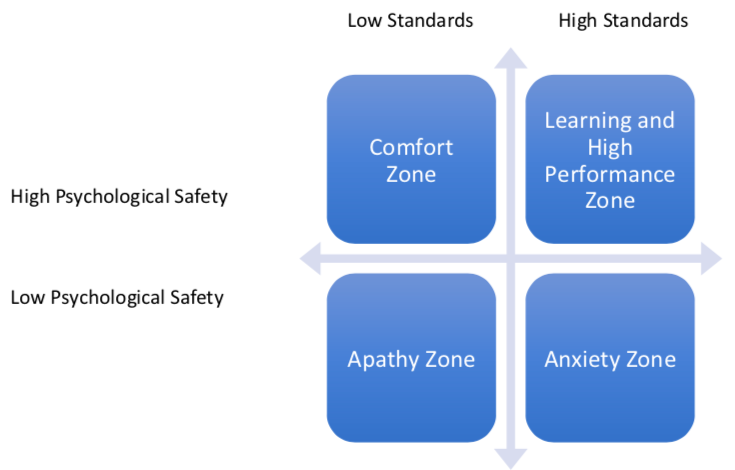Posted: 11th February, 2021
It is important to highlight that psychological safety is a not a fancy term for trust. As outlined below, they are related but fundamentally different concepts.
What is psychological safety?
Amy Edmondson (2014) defined it as “individuals’ perceptions about the consequences of interpersonal risks in their work environment. It consists of taken- for-granted beliefs about how others will respond when one puts oneself on the line, such as by asking a question, seeking feedback, reporting a mistake, or proposing a new idea.”
Two key characteristics of the psychological safety are highlighted in the literature:
It is experienced at a group level as opposed to an individual level. In a team, individual team members will tend to have similar perceptions of whether or not the team climate is psychologically safe.
The group experiences the impact of interpersonal dynamics immediately (Edmondson, 2019) as opposed a time frame of future consequences.
Why is it different from trust?
Trust relates to interactions between two individuals or parties as opposed to being experienced at a group level. Trust is an expectation that someone can be counted on to do something in a future moment, as opposed to the immediate felt sense of psychological safety. Edmondson (2019) summarised that difference as trust being about giving others the benefit of the doubt, whereas psychological safety relates to whether others will give you the benefit of the doubt as you share your thoughts or ask for help.

Table 1: Difference between Psychological Safety and Trust (Turner, 2019)
Psychological safety is a key variable of success for teams working well together and is as key to team coaching as trust is a 1 to 1 coaching relationship – it an emergent success factor that allows support and challenge to be present in the work.
Why is psychological safety relevant to team coaching?
One simple answer is that if it’s relevant to the better functioning of teams, then it is relevant to team coaching. A team coach can assist the team to continuously raise their awareness about levels of psychological safety in the room in service of the team’s functioning.
We also propose that team coaching can contribute to psychological safety and hence in turn to team functioning. Kahn (1990) identified four contributing factors to psychological safety: interpersonal relationships, group dynamics, leadership and organizational norms. All of these contributing factors are at play when a team coach works with a team. The team coach can play an important role in not only shining a light of these factors and their impact, but also in role modelling their interpersonal relationships with team members and their style of leadership. Role modelling encourages others to speak up, share ideas and ask for help. If the team coach can stay with the moments when psychological safety gets challenged (the put down, the eye roll, the mocking laugh), they can raise awareness and help build new ways of communicating within the team.
Why is psychological safety important to teams?
Team effectiveness researchers have identified the link between psychological safety and team performance (Mathieu, Maynard, Rapp & Gilson, 2008) resulting in psychological safety being identified as one of the key contributing factors (Dinh & Salas, 2017) within team effectiveness models (Burke, Stagl, Salas, Pierce, & Kendall, 2006). Dinh & Salas (2017) locate psychological safety as a core component of co-operation, a hallmark of teaming.
Psychological safety promotes candour and effective conflict management. Teams with high psychological safety are able to say what needs to be said, to listen to each other and to avoid slipping into personal conflict when dealing with task or process conflict. Table 2 below captures the important interplay between the team’s performance standards and their psychological safety in terms of how both impact the mood in the team and how they get things done.

Table 2: How psychological safety relates to performance standards (Edmondson, 2019)
As table 2 illustrates, the optimal place for teams to learn is when both psychological safety and standards are high. The role of the team coach is to give the team opportunities to identify their standards of how they want to operate together and have a ‘felt sense’ of being in a psychologically safe environment. Once the team has an understanding of these factors, they can identify for themselves how to get out of the other zones and back up into the learning zone.
However, the team coach will struggle to make a difference if the team continues to operate within its comfort zone, or there is apathy or excessive anxiety during team coaching sessions.
Why is psychological safety important for you as a team coach?
As outlined previously, psychological safety is as equally important to a team coach as it is to the functioning of the team. Being present and staying alert for critical moments that impact a team’s psychological safety is vital for a team coach. Psychological safety is vital for the team coach to meaningfully support and challenge the team while in turn helping the team develop its own collective reflection and awareness; creating teaming and learning which benefits not just the team being coached but also the stakeholders and teams that interact with that team, and by extension the entire organisation.
Bibliography
Burke, C. S., Stagl, K. C., Salas, E., Pierce, L., & Kendall, D. (2006). Understanding team adaptation: A conceptual analysis and model. Journal of Applied Psychology, 91(6).
Dinh, J. V., & Salas. E (2017). Factors that Influence Teamwork. In The Wiley- Blackwell Handbook of the Psychology of Team Working and Collaborative Processes.
Edmondson, A. C. (2019). The fearless organization: Creating psychological safety in the workplace for learning, innovation, and growth. Hoboken, New Jersey: John Wiley & Sons.
Edmondson, A. C., & Lei, Z. (2014). Psychological Safety: The History,
©Colm Murphy and Tammy Turner (2021).
Do not reproduce, circulate or re-brand without express permission.
Renaissance, and Future of an Interpersonal Construct. Annual Review of Organizational Psychology and Organizational Behavior, 1, 23–43. https://doi.org/10.1146/annurev-orgpsych-031413-091305
Kahn, W. A. (1990). Psychological Conditions of Personal Engagement and Disengagement at Work. Academy of Management Journal, 33(4), 692–724. Mathieu, J. E., Maynard, M. T., Rapp, T., & Gilson, L. (2008). Team Effectiveness
1997-2007: A Review of Recent Advancements and a Glimpse Into the Future.
Journal of Management, 34(3), 410–476.
Turner, T. (2019). “Teaming and Psychological Safety”. Australian Taxation Office, 9 August 2019, Sydney, Australia.
 Dynamic Leadership
Dynamic Leadership